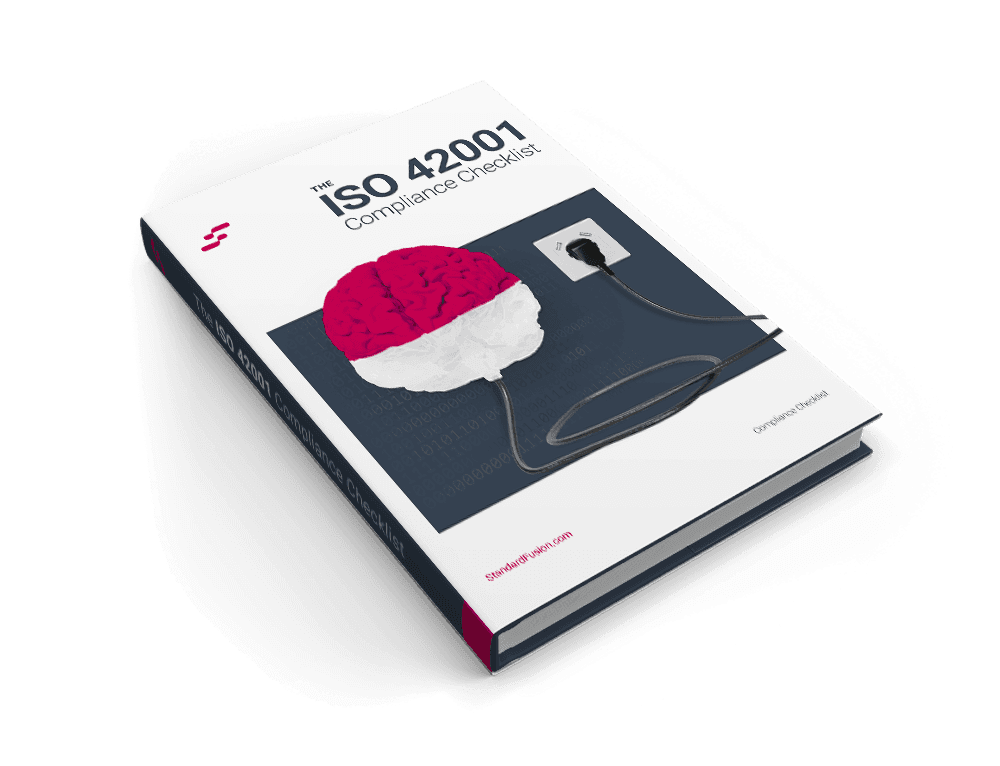Published on: Apr 24, 2025
Key Differences between ISO 42001 and NIST AI RMF
As artificial intelligence (AI) transforms industries, organizations must navigate security risks and regulatory requirements to ensure responsible deployment and the development of AI capabilities. Two leading frameworks—ISO 42001 and the NIST AI Risk Management Framework (NIST AI RMF)—offer structured approaches to AI governance and risk management.
While both frameworks help organizations manage AI-related risks, they differ in scope, objectives, and implementation. This article looks at the key distinctions between ISO 42001 and NIST AI RMF, their practical applications, and how to determine the right framework for your organization.
ISO 42001 Overview
What is ISO 42001?
ISO 42001 is the first international standard focused on AI management systems, providing a structured framework for organizations to govern AI responsibly. It outlines best practices for managing AI-related risks, ensuring compliance, and fostering ethical AI development. Designed to align with existing ISO management system standards, such as 27001 and 9001, ISO 42001 helps organizations integrate AI governance into their broader risk and quality management processes.
Scope and Purpose
ISO 42001 is a certifiable framework for organizations to manage AI systems responsibly throughout development and deployment. It applies to all industries and organization sizes, ensuring AI solutions align with ethical, safety, and regulatory requirements across various industries. The standard helps organizations establish governance policies, mitigate AI-related risks, and maintain compliance.
Key Components and Requirements
ISO 42001 requires organizations to:
Develop AI Governance Policies: Organizations must write down AI Governance Policies to create rules about AI security, define ethical practices, security, and compliance guidelines.
Conduct Risk Assessments: AI-related risks must be assessed through systematic evaluations, and their corresponding risks must be mitigated.
Ensure Ethical and Regulatory Compliance: Organizations must maintain compliance by making AI practices follow ethical and regulatory standards when developing or deploying AI systems.
Monitor and Review AI Models: Continuous review of AI models through monitoring systems should focus on performance assessment, security threats, and identification of bias.
Define Roles and Responsibilities: Organization’s should create explicit rules defining the roles and responsibilities to govern AI systems.
Obtain ISO 42001 certification: Organizations must have official ISO 42001 certification to demonstrate compliance with the standard.
NIST AI RMF Overview
What is NIST AI RMF?
The NIST AI Risk Management Framework (RMF) is a voluntary framework developed by the National Institute of Standards and Technology (NIST) to help organizations identify, assess, and mitigate AI-related risks. Unlike ISO 42001, which is a certifiable management system, NIST AI RMF provides flexible, risk-based guidance that organizations can adapt to their specific AI applications.
Scope and Purpose
Designed for businesses, government agencies, and researchers, the framework promotes trustworthy AI by emphasizing transparency, fairness, security, and accountability. It equips organizations with best practices to manage AI risks effectively while fostering innovation and compliance with ethical and regulatory expectations.
Key Components and Framework Structure
The NIST AI RMF consists of essential functions that guide organizations in managing AI-related risks effectively. Unlike ISO 42001, this framework is voluntary and does not include certification requirements.
Governance and Policy Development: Organizations should establish AI risk management policies to ensure responsible AI development and deployment.
Map Risk Identification: AI risk identification systems should be implemented to detect safety hazards and assess potential operational consequences.
Measure Risk Measurement: Organizations should use metrics and assessments to evaluate AI risks and track system performance.
Manage Risk Mitigation: AI risk management strategies should be implemented to minimize risks and ensure AI systems remain trustworthy.
Continuous Monitoring and Improvement: Organizations should regularly update AI governance strategies based on evolving risks, emerging threats, and technological advancements.
Key Differences Between ISO 42001 and NIST AI RMF
Feature | ISO 42001 | NIST AI RMF |
|---|---|---|
Type of Framework | Management system standard | Risk-based guidance framework |
Purpose | AI governance and compliance | AI risk mitigation |
Certification | Certifiable standard | Voluntary framework |
Scope | AI management system for organizations | AI risk management practices |
Industry Adoption | Used by organizations seeking AI compliance certification | Used by businesses, governments, and researchers for AI risk assessments |
Risk Assessment Approach | Includes structured risk management as part of AI governance | Provides flexible, voluntary risk assessment guidance |
Regulatory Alignment | Supports compliance with global AI regulations and industry standards | Encourages risk-aware AI practices but does not mandate specific governance measures |
Implementation Requirements | Requires documented policies, governance structures, and continuous monitoring | Encourages risk-aware AI practices but does not mandate specific governance measures |
Integration With Other Standards | Aligns with ISO 27001 and ISO 9001 | Compliments AI ethics principles and risk management methodologies |
Which Framework Best Suits Your Organizational Needs
Choosing between ISO 42001 and NIST AI RMF depends on your organization’s goals, regulatory requirements, and overall approach to AI governance.
ISO 42001 is best suited for organizations that require a structured, certifiable AI management system with defined governance policies, compliance frameworks, and ongoing risk assessments. It aligns well with industries needing formal AI governance, such as finance, healthcare, and government-regulated sectors.
NIST AI RMF is ideal for organizations seeking a flexible, voluntary, and risk-driven approach to AI management. It is particularly beneficial for businesses, research institutions, and government agencies that prioritize adaptability in AI risk assessment without needing mandatory certification.
Can Organizations Integrate Both Frameworks?
Organizations looking for a comprehensive AI governance strategy can integrate both frameworks, leveraging the risk assessment flexibility of NIST AI RMF alongside the structured governance requirements of ISO 42001. Combining both approaches helps organizations enhance AI trustworthiness, here are some ways companies can use both to create a comprehensive AI management system:
Develop AI Governance Policies & Risk-Based AI Assessments
Use ISO 42001 to establish formal AI policies, compliance procedures, and ethical guidelines.
Apply NIST AI RMF to conduct ongoing risk assessments and identify emerging AI-related threats.
2. Align AI Risk Identification with Compliance Requirements
Map AI risks using NIST AI RMF’s flexible assessment guidelines.
Ensure risk identification aligns with ISO 42001’s compliance and governance requirements.
Use Risk Metrics to Strengthen ISO 42001 Compliance
Implement NIST AI RMF’s risk measurement tools to track AI system performance, bias detection, and security vulnerabilities.
Use the data from the risk assessment to support ISO 42001’s audit and compliance processes.
4. Integrate Risk Mitigation Strategies from Both Frameworks
Apply NIST AI RMF’s risk response strategies to proactively address AI vulnerabilities.
Ensure risk mitigation aligns with ISO 42001’s structured risk management approach for long term AI governance.
Establish Clear Roles and Responsibilities
Use ISO 42001 to define formal AI governance roles and responsibilities within the organization.
NIST AI RMF can support the defined teams and team members understand how to assess and respond to AI risks.
Enhance AI Trustworthiness and Transparency
ISO 42001 formalizes AI governance, ensuring ethical AI deployment.
NIST AI RMF improves transparency by incorporating risk-based insights into AI decision-making.
Monitor and Improve AI Systems Continuously
Use NIST AI RMF’s ongoing risk evaluations to detect changes in AI behavior, biases, or security threats.
Align insights from risk evaluations with ISO 42001’s monitoring and governance policies to ensure AI systems remain compliant and trustworthy.
8. Balance Regulatory Compliance with Adaptability
ISO 42001 ensures compliance adherence to AI standards and regulatory requirements through certification.
NIST AI RMF offers flexibility to adapt to evolving risks and maintain industry best practices.
Organizations can seek ISO 42001 certification while using NIST AI RMF as a supplementary tool for internal AI risk assessments and audits.
Conclusion
As AI adoption continues to grow across industries, organizations must implement effective governance and risk management strategies to ensure ethical, secure, and complaint AI systems. While ISO 42001 is ideal for organizations seeking formal AI governance and certification, NIST AI RMF supports businesses, government agencies, and researchers in implementing adaptable risk management strategies.
Organizations that leverage both of the complementary approaches can strengthen AI trustworthiness, enhance regulatory alignment, and proactively mitigate AI-related risks. This combined approach ensures responsible and sustainable AI deployment, helping organizations navigate the complexities of AI governance while fostering innovation and accountability.







